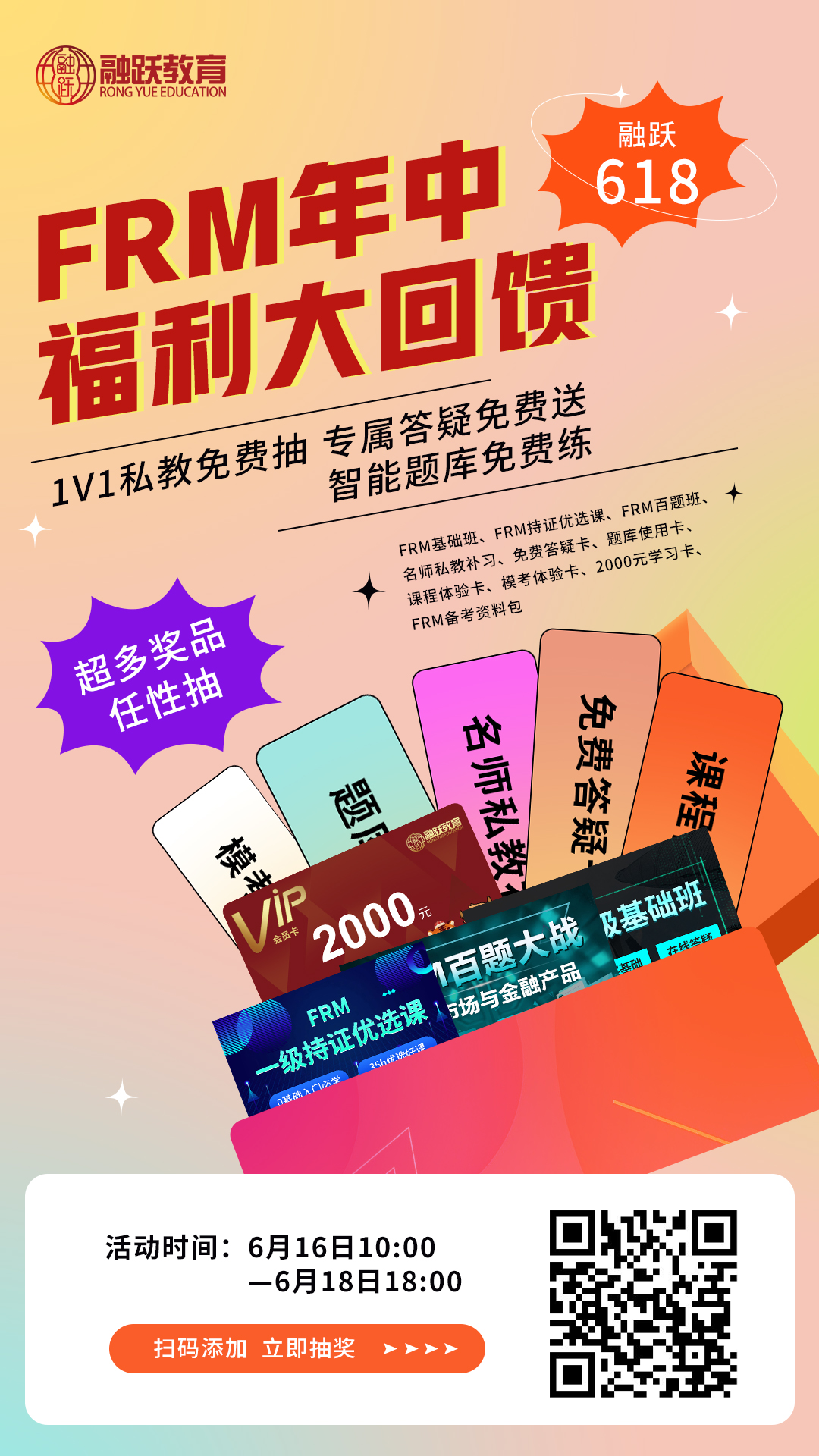在FRM二級(jí)考試中是有80道選擇題,考生在備考后期一定要做大量的真題練習(xí),尤其是近兩年的真題練習(xí),下文是小編列舉的相關(guān)真題,希望對(duì)備考的你有所幫助!
》》》2022年新版FRM一二級(jí)內(nèi)部資料免·費(fèi)領(lǐng)取!【精華版】
Afirm’s financial planning department reports that a project’s proposed risk-adjusted return on capital (RAROC) is 13%, the risk-free rate is 3%, the market return is 11%, and the firm’s equity beta is 1.3. Use adjusted risk-adjusted return on capital (ARAROC) to determine whether or not the project should be accepted. This firm should:
A) Reject the project because its expected ARAROC is higher than the risk-free rate.
B) Accept the project because its expectedARAROC is higher than the market’s risk-free rate
C) Accept the project because its expectedARAROC is lower than the market’s risk-free rate
D) Reject the project because its expected ARAROC is lower than the market’s risk-free rate
答案:D
解析:ARAROC = 0.13-1.3*(0.11-0.03)=2.6% The project should be rejected because theARAROC of 2.6% is less than the risk-free rate.
Assume a bank’s $2.0 billion corporate loan portfolio offers a return of 6% per annum. The expected loss on the portfolio is estimated to be 1.5% per annum; i.e., $30 million. The portfolio is funded by $2 billion in retail deposits with a transfer-priced interest rate charge of 2%. The bank has a direct operating cost of $16 million per annum and an effective tax rate of 25%. Risk analysis of unexpected losses associated with the portfolio tell us we need to set aside economic capital of $200 million against the portfolio; i.e., 10% of the loan amount. The bank’s economic capital must invested in risk-free securities and, unfortunately in the regime of ultra low interest rates, the risk-free rate on government securities is only 1%.Although the loan portfolio’s risk-adjusted return on capital (RAROC) is positive and seemingly high, the bank wants to adjust the traditional RAROC calculation to obtain a RAROC measures that take into account the systemic riskiness of the expected returns. If the risk-free rate is 1%, and the expected rate of return on the market portfolio is 8% such that the equity risk premium is 7%, and the beta of the firm’s equity is 1.6, which of the following is the correct adjusted RAROC and is the project advisable?
A) RAROC is 6.25% but no, the project is bad becauseARAROC is below the risk-free rate.
B) RAROC is 8% but no, the project is bad becauseARAROC is below the risk-free rate.
C) RAROC is 9.8% and yes, the project is good because ARAROC is above the risk-free rate.
D) RAROC is 13.5% and yes, the project is good because ARAROC is above the
risk-free rate.
答案:D
解析: Expected revenue = $2.0 billion loan portfolio × 6.0% = $120.0 million
Expected losses = $2.0 billion loan portfolio × 1.5% = $30.0 million Interest expense
= $2.0 billion borrowed funds × 2.0% = $40.0 million Operating cost = $16.0 million
(given as an assumption) Economic capital = $200.0 million = 10.0% × $2.0 billion
(given as an assumption) Return on economic capital (EC) = $2.0 million = $200.0
EC × 1.0% Tax rate = 0.25 (given as assumption) Such that RAROC = [($120.0 - 30.0
- 40.0 - 16.0 + 2.0) × (1.0 - 0.25 tax rate)] / 200.0 = 13.50%Adjusted RAROC =
RAROC - β(e) × [R(m) - Rf] = 13.50% - 1.60 × [8.0% - 1.0%] = 2.30% and 2.30% is
greater than the risk-free rate.
如果想要獲得更多關(guān)于FRM考試的真題解析,點(diǎn)擊在線(xiàn)咨詢(xún)或者添加融躍老師微信(rongyuejiaoyu)!
閱讀排行
- 1 FRM考試報(bào)名條件、報(bào)名費(fèi)用、報(bào)名時(shí)間!
- 2 FRM考試科目有哪些?不同科目應(yīng)該如何備考?
- 3 FRM考試報(bào)名時(shí)間和報(bào)名費(fèi)用!
- 4 FRM證書(shū)在國(guó)內(nèi)含金量高嗎?持有FRM證書(shū)可以從事什么工作?
- 5 FRM考試備考學(xué)習(xí)資料和建議!
- 6 如何快速掌握FRM高頻考點(diǎn)的典型考法?
- 7 11月FRM一級(jí)中文考試考前沖刺秘籍:30天決勝指南
- 8 FRM證書(shū)適合的行業(yè)和人群有哪些?
- 9 2026年FRM報(bào)考時(shí)間已經(jīng)出爐
- 10 FRM考試剩余一個(gè)月!備考過(guò)程中有哪些需要注意的?
- 報(bào)考條件
- 報(bào)名時(shí)間
- 報(bào)名費(fèi)用
- 考試科目
- 考試時(shí)間
-
GARP對(duì)于FRM報(bào)考條件的規(guī)定:
What qualifications do I need to register for the FRM Program?
There are no educational or professional prerequisites needed toregister.
翻譯為:報(bào)名FRM考試沒(méi)有任何學(xué)歷或?qū)I(yè)的先決條件。
可以理解為,報(bào)名FRM考試沒(méi)有任何的學(xué)歷和專(zhuān)業(yè)的要求,只要是你想考,都可以報(bào)名的。查看完整內(nèi)容 -
2024年5月FRM考試報(bào)名時(shí)間為:
早鳥(niǎo)價(jià)報(bào)名階段:2023年12月1日-2024年1月31日。
標(biāo)準(zhǔn)價(jià)報(bào)名階段:2024年2月1日-2024年3月31日。2024年8月FRM考試報(bào)名時(shí)間為:
早鳥(niǎo)價(jià)報(bào)名階段:2024年3月1日-2024年4月30日。
標(biāo)準(zhǔn)價(jià)報(bào)名階段:2024年5月1日-2024年6月30日。2024年11月FRM考試報(bào)名時(shí)間為:
早鳥(niǎo)價(jià)報(bào)名時(shí)間:2024年5月1日-2024年7月31日。
標(biāo)準(zhǔn)價(jià)報(bào)名時(shí)間:2024年8月1日-2024年9月30日。查看完整內(nèi)容 -
2023年GARP協(xié)會(huì)對(duì)FRM的各級(jí)考試報(bào)名的費(fèi)用作出了修改:將原先早報(bào)階段考試費(fèi)從$550上漲至$600,標(biāo)準(zhǔn)階段考試費(fèi)從$750上漲至$800。費(fèi)用分為:
注冊(cè)費(fèi):$ 400 USD;
考試費(fèi):$ 600 USD(第一階段)or $ 800 USD(第二階段);
場(chǎng)地費(fèi):$ 40 USD(大陸考生每次參加FRM考試都需繳納場(chǎng)地費(fèi));
數(shù)據(jù)費(fèi):$ 10 USD(只收取一次);
首次注冊(cè)的考生費(fèi)用為(注冊(cè)費(fèi) + 考試費(fèi) + 場(chǎng)地費(fèi) + 數(shù)據(jù)費(fèi))= $1050 or $1250 USD。
非首次注冊(cè)的考生費(fèi)用為(考試費(fèi) + 場(chǎng)地費(fèi)) = $640 or $840 USD。查看完整內(nèi)容 -
FRM考試共兩級(jí),F(xiàn)RM一級(jí)四門(mén)科目,F(xiàn)RM二級(jí)六門(mén)科目;具體科目及占比如下:
FRM一級(jí)(共四門(mén)科目)
1、Foundations of Risk Management風(fēng)險(xiǎn)管理基礎(chǔ)(大約占20%)
2、Quantitative Analysis數(shù)量分析(大約占20%)
3、Valuation and Risk Models估值與風(fēng)險(xiǎn)建模(大約占30%)
4、Financial Markets and Products金融市場(chǎng)與金融產(chǎn)品(大約占30%)
FRM二級(jí)(共六門(mén)科目)
1、Market Risk Measurement and Management市場(chǎng)風(fēng)險(xiǎn)管理與測(cè)量(大約占20%)
2、Credit Risk Measurement and Management信用風(fēng)險(xiǎn)管理與測(cè)量(大約占20%)
3、Operational and Integrated Risk Management操作及綜合風(fēng)險(xiǎn)管理(大約占20%)
4、Liquidity and Treasury Risk Measurement and Management 流動(dòng)性風(fēng)險(xiǎn)管理(大約占15%)
5、Risk Management and Investment Management投資風(fēng)險(xiǎn)管理(大約占15%)
6、Current Issues in Financial Markets金融市場(chǎng)前沿話(huà)題(大約占10%)查看完整內(nèi)容 -
2024年FRM考試時(shí)間安排如下:
FRM一級(jí)考試:
2024年5月4日-5月17日;
2024年8月3日(周六)上午;
2024年11月2日-11月15日。FRM二級(jí)考試:
2024年5月18日-5月24日;
2024年8月3月(周六)下午;
2024年11月16日-11月22日。查看完整內(nèi)容
-
中文名
金融風(fēng)險(xiǎn)管理師
-
持證人數(shù)
25000(中國(guó))
-
外文名
FRM(Financial Risk Manager)
-
考試等級(jí)
FRM考試共分為兩級(jí)考試
-
考試時(shí)間
5月、8月、11月
-
報(bào)名時(shí)間
5月考試(12月1日-3月31日)
8月考試(3月1日-6月30日)
11月考試(5月1日-9月30日)









